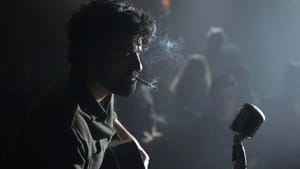Stay in the Loop
BSR publishes on a weekly schedule, with an email newsletter every Wednesday and Thursday morning. There’s no paywall, and subscribing is always free.
The production value of nostalgia
'Inside Llewyn Davis' and 'Her'

Can a film make you miss something you’ve never known? That is a tall order in cinema, but two new films, Inside Llewyn Davis and Her, succeed brilliantly at doing this. These works not only transport us to other eras, but also stir in us a deep nostalgia. Each film produces a paradoxical longing for another time — perhaps a time we never lived through, or a time that is yet to exist.
They achieve this powerful sensation at the visual level, crafting nostalgia through intricate production design. For directors Joel and Ethan Coen, the visual inspiration for Inside Llewyn Davis came from folk music album covers of the early 1960s. Prior to the film’s release, the Coens discussed this influence at an event in SoHo, not far from the Greenwich Village stomping grounds depicted in their film. Here, Ethan Coen explained that their job as period filmmakers was to harness the emotional charge of old album covers visually, not verbally. “One of the things you get to do when you do a period movie,” Joel Coen added, “is create a world for the camera.” Inside Llewyn Davis does exactly that, wrapping viewers up in another world for the duration of the film. And whether or not you’ve experienced Greenwich Village in the winter of ’61, you develop a wistful affection for that moment.
This “world for the camera” comes to life through rich production design, careful attention by the art director, and perhaps most significantly, through lighting. This is the work of director of photography Bruno Delbonnel, who gives the film an atmosphere that pulls on our nostalgic heartstrings. Delbonnel manipulates the lighting so that it barely reaches the back of any given scene. His light has a way of falling off into darkness, which conveys the hopeless tone of the story in a way that words cannot.
Delbonnel also manipulated the film’s color palette to produce the blue atmosphere that characterizes Inside Llewyn Davis. The result is a desaturated shade of winter that transports us to — and even chills us with — those slushy New York streets. Although the color work behind Spike Jonze’s Her is the opposite — it eliminated blue to leave only the gold and red tones — it produces the same effect of reminiscence. Her has the warm glow of a sweet memory, priming us for our own nostalgia.
Rembrance of things not yet happened 
Her’s visual effect is especially moving because it drives us towards nostalgic feelings for something that is still in the future. It makes us long for a time that we haven’t actually lost yet. Indeed, what makes Jonze’s portrayal of the future so wonderful is the way it gently touches on the past. The film’s design of cell phones, for example, does not imitate slicker versions of today’s technology. Rather, it resembles a sort of antique photo album, long gone in the digital age of Her. Similarly, the costume design does not seek to invent a new fashion but draws from past trends. High-waisted pants, collarless shirts, a lack of blue jeans – these subtleties create a look that is believably futuristic, just faintly different from our own time.
Details like this, in both films, create period pieces that are more than just believable representations of another time. They make us willing to be transported there. And, in a beguiling twist of timelessness, they make us long to return to those moments we’ve never actually known.
Sign up for our newsletter
All of the week's new articles, all in one place. Sign up for the free weekly BSR newsletters, and don't miss a conversation.
 Kayleigh Butera
Kayleigh Butera